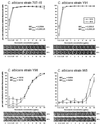Novel fluorescent broth microdilution method for fluconazole susceptibility testing of Candida albicans
- PMID: 11427602
- PMCID: PMC88218
- DOI: 10.1128/JCM.39.7.2708-2712.2001
Novel fluorescent broth microdilution method for fluconazole susceptibility testing of Candida albicans
Abstract
A comparative evaluation of the reference National Committee for Clinical Laboratory Standards (NCCLS) broth microdilution method with a novel fluorescent carboxyfluorescein diacetate (CFDA)-modified microdilution method for the susceptibility testing of fluconazole was conducted with 68 Candida strains, including 53 Candida albicans, 5 Candida tropicalis, 5 Candida glabrata, and 5 Candida parapsilosis strains. We found trailing endpoints and discordant fluconazole MICs of < 8 microg/ml at 24 h and of > or =64 microg/ml at 48 h for 12 of the C. albicans strains. These strains satisfy the definition of the low-high MIC phenotype. All 12 low-high phenotype strains were correctly shown to be susceptible at 48 h with the CFDA-modified microdilution method. For the 41 non-low-high phenotype C. albicans strains, the CFDA-modified microdilution method yielded 97.6% (40 of 41 strains) agreement within +/-1 dilution at 24 h compared with the reference method and 92.7% (38 of 41 strains) agreement within +/-1 dilution at 48 h compared with the reference method. The five strains each from C. tropicalis, C. glabrata, and C. parapsilosis that were tested showed 100% agreement within +/-2 dilutions for the two methods being evaluated.
Figures


References
-
- Arthington-Skaggs B A, Warnock D W, Morrison C J. Quantitation of Candida albicans ergosterol content improves the correlation between in vitro antifungal susceptibility test results and in vivo outcome after fluconazole treatment in a murine model of invasive candidiasis. Antimicrob Agents Chemother. 2000;44:2081–2085. - PMC - PubMed
-
- Banerjee S N, Emori T G, Culber D H, Gaynes R P, Jarvis W R, Horan T, Edwards J R, Tolson J, Henderson T, Marton W J the National Nosocomial Infections Surveillance System. Secular trends in nosocomial primary bloodstream infections in the United States, 1980–1989. Am J Med. 1991;91(Suppl. 3B):86S–89S. - PubMed
-
- Beck-Sagué C M, Jarvis W R the National Nosocomial Infections Surveillance System. Secular trends in the epidemiology of nosocomial fungal infections in the United States, 1980–1990. J Infect Dis. 1993;167:1247–1251. - PubMed
-
- Centers for Disease Control and Prevention. National nosocomial infections surveillance (NNIS) report, data summary from October 1986-April 1996, issued May 1996. A report from the National Nosocomial Infections Surveillance (NNIS) System. Am J Infect Control. 1996;24:380–388. - PubMed
-
- Edwards J E, Jr, Bodey G P, Bowden R A, Büchner T, de Pauw B E, Filler S G, Ghannoum M A, Glauser M, Herbrecht R, Kauffman C A, et al. International conference for the development of a consensus on the management and prevention of severe candidal infections. Clin Infect Dis. 1997;25:43–59. - PubMed
Publication types
MeSH terms
Substances
LinkOut - more resources
Full Text Sources

